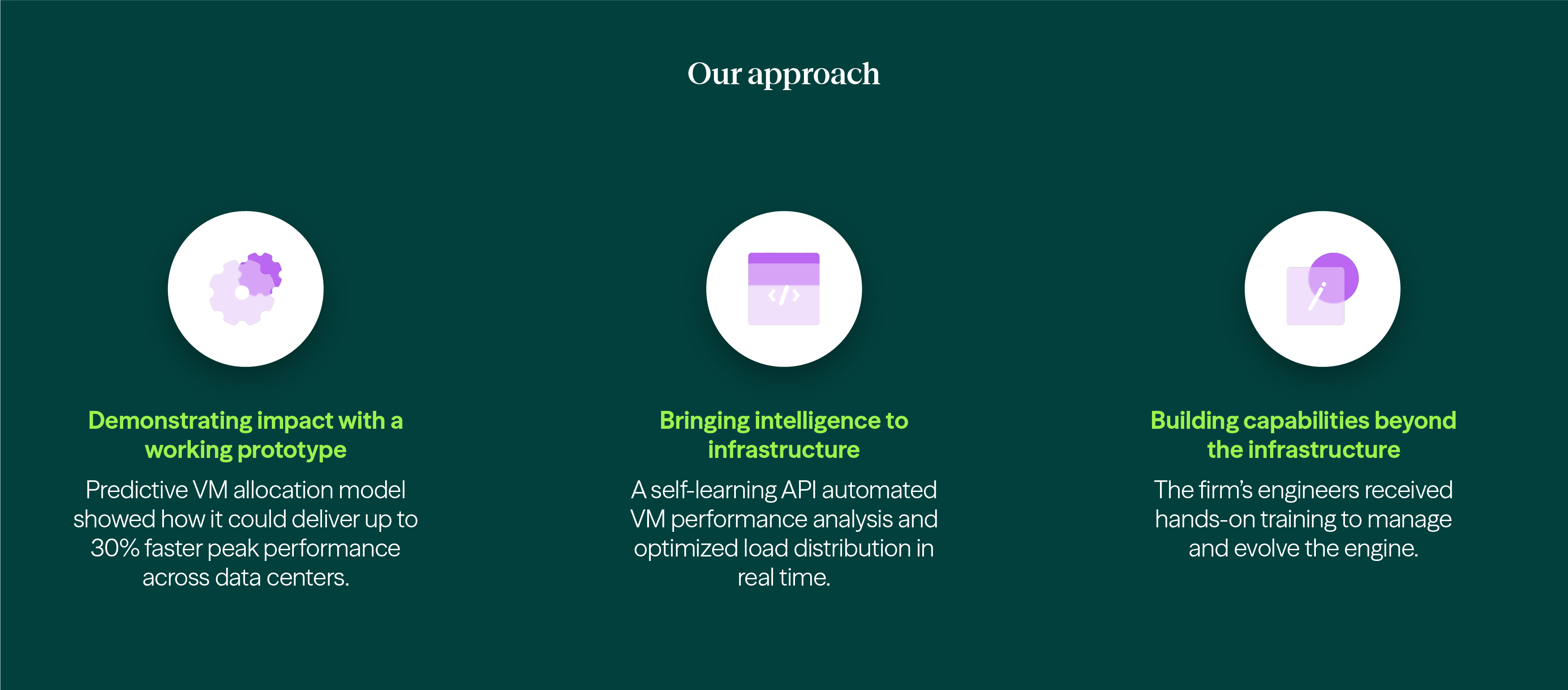Cloud provider boosts VM performance by 30% with predictive intelligence
Modus Create partnered with a cloud provider to develop and deploy a predictive allocation engine that improves operational performance by up to 30%.

Table of contents
Table of contents
Subscribe via Email
Subscribe to our blog to get insights sent directly to your inbox.
A leading cloud provider partnered with Modus Create to improve virtual machine (VM) performance across its 9 regions with over 200,000 customers. Uneven VM distribution was wasting capacity, driving up infrastructure costs, and creating an inconsistent user experience. Our experts helped develop and deploy a predictive allocation engine that utilizes real-time performance data to recommend intelligent VM migrations and keep workloads balanced across servers.
Our work involved
- Predictive model development and validation
- API layer for automated VM migration recommendations
- Automation scripts for data collection and model retraining
- Documentation, knowledge transfer, and enablement
Impact
15%
30%
Lower
Improved
When you’re running over 400,000 data centers serving 190 countries, even small inefficiencies can snowball into massive costs.
A global cloud infrastructure provider was grappling with this problem. Across its global data centers, uneven virtual machine workloads created a widening gap. Some physical nodes were stretched thin while others sat underutilized. The imbalance drove up costs, reduced efficiency, and led to inconsistent performance for customers.
The system had grown beyond the company’s ability to manage it with conventional heuristic methods. To sustain performance at scale, it needed a smarter way to see, predict, and balance workloads before they could affect customer experience.
Challenge
Inefficient VM workloads
The root of the problem lay in how virtual machines were distributed across the company’s data center infrastructure. Each server carried a different load profile, and over time, the imbalance had become a concern. Some servers ran close to capacity, degrading performance for customers, while others sat largely unused.
The firm’s existing monitoring tools surfaced metrics but offered little foresight. As a result, its engineers were often left firefighting. They had to manually migrate VMs to restore balance, only to face new bottlenecks days later.
Modus Create’s cross-disciplinary team of
- a machine learning engineer
- a backend software engineer
- a project manager
partnered with the company to work on a solution that improves the experience of the firm’s customers and, at the same time, optimizes resources required to run the servers.
Solution
Building a predictive allocation engine
The company needed a system that could:
- predict usage trends
- automate VM allocation
- continuously optimize performance
across heterogeneous hardware. Based on intuition honed by years of experience running the systems, the company’s engineers believed that predictive intelligence could handle these tasks more effectively than its existing set of simple rules. But before investing in building a new allocation framework, they needed more than just intuition. They needed proof that it would work.

Demonstrating the predictive model’s impact with a working prototype
We started the project with a discovery phase to understand the core issues and validate the solution. The team conducted exploratory data analysis to uncover patterns in how virtual machines were distributed across hosts and how those distributions affected performance. This data served as fuel for building several predictive models capable of forecasting load and identifying imbalances before they impacted users.
The team delivered a prototype proving that predictive VM allocation could reduce slowness and improve resource utilization. Using SensorVM benchmarks, it predicted host performance and recommended smart migrations via API. Early tests showed up to 30% improvement in peak slowness and 5–15% gains on average, validating the model’s impact across diverse data centers.
Bringing intelligence to the cloud company’s infrastructure
The success of this proof of concept proved to the company’s leadership that the predictive allocation engine could deliver improvements in performance and efficiency. So, they gave the go-ahead for the team to deploy the engine as an API layer that could be embedded into the infrastructure management backend. During deployment, the team fine-tuned how the system defined ‘slow’ and ‘fast’ hosts, ensuring thresholds were calibrated to avoid false positives and unnecessary migrations.
The resulting engine analyzed real-time performance data of virtual machines and recommended which VMs to migrate and where to place them for optimal load distribution. The migrations were then carried out automatically by the customer’s existing systems. In addition, Modus Create provided automation scripts that handled data collection, model retraining, and continuous monitoring, allowing the system to learn and improve with each iteration.
Building capabilities beyond the intelligent infrastructure
Right from the beginning of the project, the team’s focus was on building capabilities, not just in the cloud infrastructure but also in the company’s own engineering team. The final phase focused on knowledge transfer through:
- documentation,
- workshops
- live training sessions
By the end of the project, the client’s engineers could retrain models, adjust parameters, and extend functionality independently. The predictive allocation engine became a living part of their infrastructure with a clear path to continuous improvement.
Impact
Optimized VMs, operational savings
The predictive allocation engine turned uncertainty in the cloud company’s operations into consistent, measurable returns. With real-time insights guiding every decision, the company could finally forecast system behavior and act before performance issues appeared. The result was a more stable, efficient, and cost-effective infrastructure that performed better for both customers and teams.
The Modus Create team’s unwavering focus on agile principles and lean execution enabled the project to finish ahead of schedule and 20% under the initial budget.
Some VMs saw rapid improvements within hours, while others experienced steady, lasting progress as the system continued learning and refining its recommendations. Key results included:
- 15% improvement in overall performance across most environments.
- Up to 30% performance gain in high-variance workloads.
- Lower operational overhead as manual rebalancing was replaced with automation.
- Consistent user experience across regions and infrastructure generations.
Beyond the numbers, the cloud provider gained confidence in its operations. Its engineers are now fully equipped to manage the predictive allocation engine themselves and make continuous improvements. The engagement proved that intelligence delivers where scale alone cannot. With performance stabilized and costs contained, the company now runs a smarter, leaner infrastructure that keeps improving with every cycle.
Related Customer Stories
Discover more customer stories.


